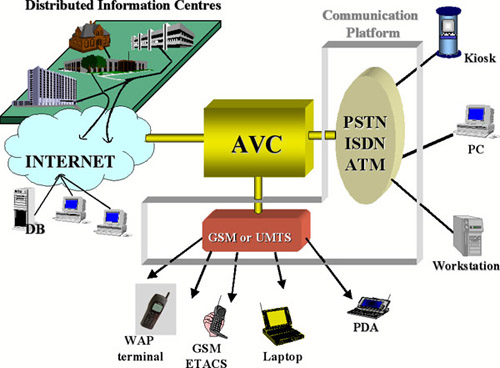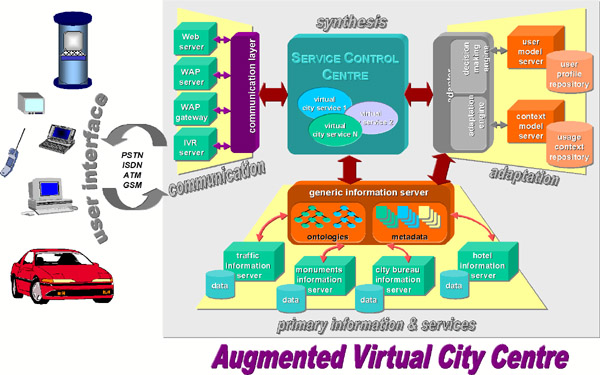
|
|
ERCIM News No.46, July 2001 [contents]
|
by Pier-Luigi Emiliani, Michael Pieper and Constantine Stephanidis
PALIO, a new project recently funded by the European Commission’s Information Society Technologies (IST) Programme, builds on previous European research and technological development efforts to provide a novel understanding of anyone, anywhere access to community-oriented services. This brief article reports on the aims and objectives of the project, as well as its potential contributions to the universal access community in Human Computer Interaction.
The notion of universal access to the Information Society is rooted on the concept of universal design, as it has evolved over the years. Universal design refers to the conscious effort to consider and take account of the widest possible range of end user requirements throughout the development life-cycle of product or service. In recent years, it has been applied in interior and workplace design, housing and landscapes.
In the context of Human Computer Interaction, design for all implies a proactive approach towards products and environments that can be accessible and usable by the broadest possible end-user population, without the need for additional adaptations or specialized (re-)design. Building upon the results of earlier projects, such as ACCESS and AVANTI, we are now pursuing the universal access challenge at another level. Specifically, the PALIO project sets out to address the issue of anyone and anywhere access to community-wide services. This is an extension of previous efforts, as it accommodates a broader perspective on adaptation and covers a wider range of interactive encounters beyond desktop access. In what follows, we will briefly overview how this project addresses the issue of universal access and how it advances the current state of affairs by considering novel types of adaptation based on context and situation awareness.
The PALIO project is funded by the EC’s IST Programme. The main challenge of the PALIO project is the creation of an open system for accessing and retrieving information without constraints and limitations (imposed by space, time, access technology, etc.). Therefore, the system should be modular and capable of interoperating with other existing information systems. In this scenario, mobile communication systems will play an essential role, because they enable access to services from anywhere and at anytime. One important aspect of the PALIO system will be the support of a wide range of communication technologies (mobile or wired) to access services. In particular, it will be possible for a user equipped either with a common cellular phone or an advanced WAP phone to access services wherever he/she is. The Augmented Virtual City (AVC) centre will adapt the presentation of information to the different access technologies (Figure 1).
The PALIO system envisages the adaptation of both the information content and the way in which it is presented to the user, as a function of user characteristics (eg, abilities, needs, requirements, interests); user location with the use of different modalities and granularities of the information contents; context of use; the current status of interaction (and previous history); and finally used technology (eg, communication technology, terminal characteristics, special peripherals).
The PALIO information system consists of the following main elements (see Figure 1):
 |
| Figure 1: PALIO architecture. |
The AVC centre is the architectural unit that manages diversity and implements the mechanisms for universal access. The AVC will be perceived by users as a system which groups together all information and services that are available in the city. It will serve as an augmented, virtual facilitation point from which different types of information and services can be accessed. The context- and location- awareness, as well as the adaptation capabilities of the AVC, will enable users to experience their interaction with services as a form of ‘contextually grounded’ dialogue, eg, the system always knows the user’s location and can correctly infer what is ‘near’ the user, without the user having to explicitly provide information to the system.
The envisaged main building blocks of the AVC are depicted in Figure 2, and can be broadly categorised (according to their role within the project) into the adaptation infrastructure; the service control centre; the software communication layer to and from the user terminals; the distributed information services and their integration infrastructure.
 |
| Figure 2: Augmented Virtual City Centre architecture. |
It should be noted that one of the very important properties of the described architecture is the fact that there is continuous monitoring of the interaction between users and the PALIO system, so that modifications in the user behaviour, the context of use, or the status of communication facilities and devices can be identified, interpreted, and used to trigger the appropriate type of adaptations (eg, inclusion of links to relevant information, spatial or temporal restructuring of information elements, modification of presentation parameters such font, colour, voice gender, volume, etc). Central for the design of adaptations based on context-sensitive process-oriented knowledge is the Basic PALIO Tourist Scenario Framework, which comprehensively describes touristic situations, and forms the basis for deriving numerous information needs of tourists, and corresponding service requirements including situation-dependent user interface adaptations and accessible hardware devices. The framework distinguishes between exogenous, intervening and endogenous dimensions of scenario descriptions. The PALIO basic user model conceptualizes tourists’ information processing behaviour in terms of behavioural means-end analysis. Rules for interface and content adaptation in PALIO are inferred from the interplay between the Basic PALIO Tourist Scenario Framework and the PALIO basic user model.
Acknowledgements
The partners of the IST-PALIO project are: ASSIOMA S.p.A.(Italy)—Prime Contractor; CNR-IROE (Italy); Comune di Firenze (Italy); FORTH-ICS (Greece); GMD (Germany); Telecom Italia Mobile S.p.A. (Italy); University of Siena (Italy); Comune di Siena (Italy); MA Systems and Control Ltd (UK); FORTHnet (Greece).
Please contact:
Pier-Luigi Emiliani — IROE-CNR
Tel: +39 55 4235 235
E-mail: ple@iroe.fi.cnr.it
Michael Pieper — GMD
Tel: +49 2241 14 2018
E-mail: michael.pieper@gmd.de
Constantine Stephanidis — FORTH -ICS
Tel: +30 81 39 1741
E-mail: cs@ics.forth.gr